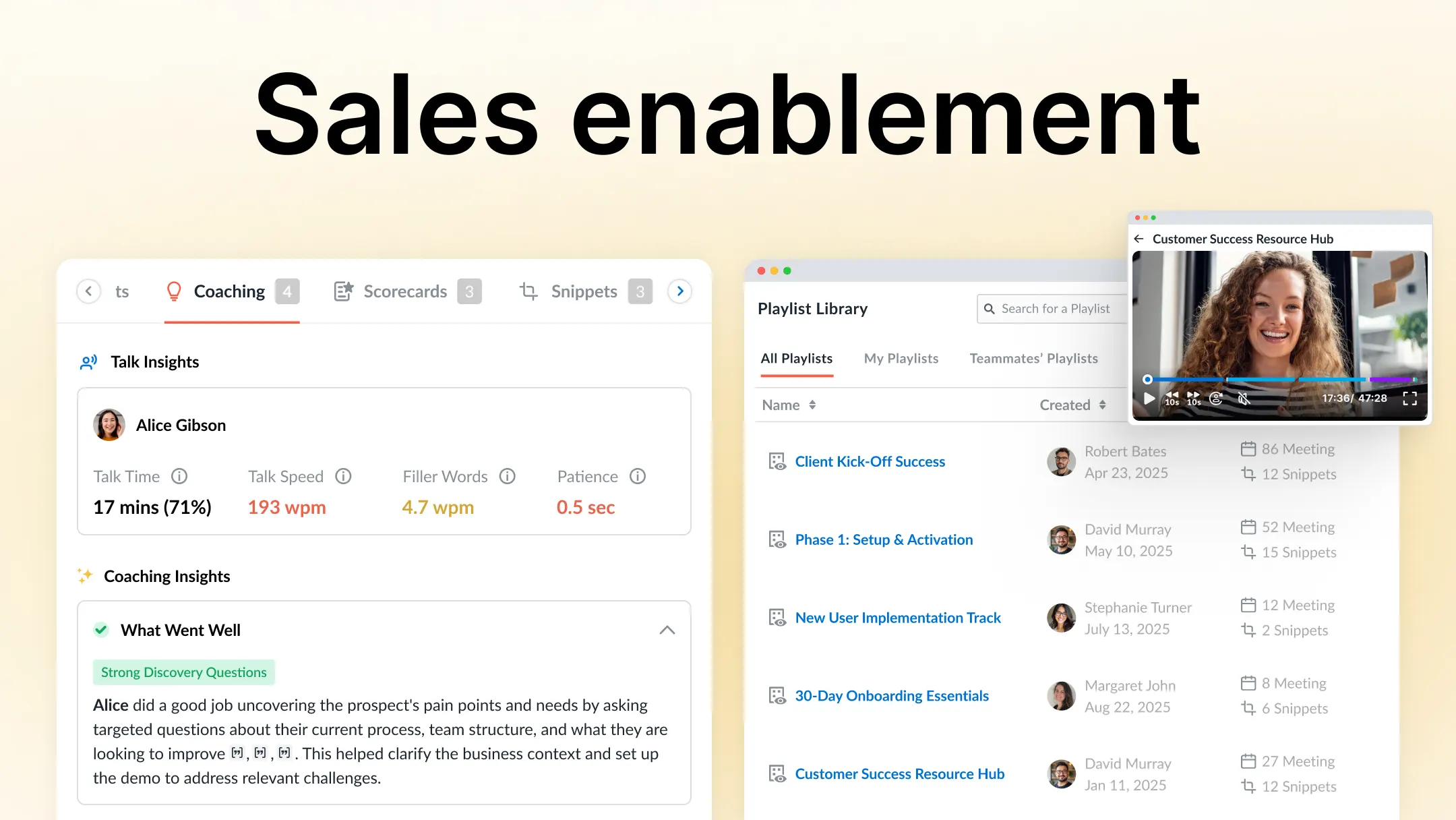Revenue leak prevention with modern coaching and forecasting
Table of Contents:

Recently, at Avoma, we uncovered that for most SMBs and mid-market organizations, 15.4% of the revenue, though potentially earned, is left uncaptured. An average of 15% revenue leak happens on every deal you’re working on, where potential revenue is lost due to inefficiencies in the sales, customer success, and forecasting process.
This blog post will explore how sales coaching and forecasting can significantly reduce revenue leaks and increase your overall profitability.
So, firstly, the basics.
What is a revenue leak?
Revenue leak is often used in business to describe situations where money is left untaken on the table. This leak can occur in many forms, including inefficient sales and customer success processes, unpaid invoices, unmonitored risks across deals, and more. These leaks can hinder a company's financial performance and growth.
However, revenue leak is not just about money being lost but also representing lost opportunities. For instance, a customer dissatisfied with a lousy product or service is unlikely to return and buy again or recommend the company to others. Hence, a potential source of future revenue is lost.
One of the biggest causes of revenue leakage is offering discounts too often or too deep. The worst is not reporting the discounts at all. However, the real issue is when reps begin to leverage discounts to compensate for not selling the value of your product or not ensuring customer fit.
Here are some quick ways to address each of these issues:
- Non-reported discounts: Sales and customer success managers can review reports and invoices to look for discounts that have not been recorded. You can implement a process to ensure reps enter all discounts into the CRM system.
- Frequent discounts: You can train their reps on how to sell to customer needs without relying on discounts. You can follow it up by creating a pricing policy limiting the number of discounts that can be offered.
- Massive discounts: Start investigating why these discounts are being offered and take steps to address the underlying problem. For example, if the discounts are being offered to win new customers, then your sales team may need to be trained on how to better position the value proposition of the product.
By addressing these issues, you can reduce revenue leakage and improve their bottom line.
Preventing revenue leak with coaching
Proper coaching involves continuous training and development of your sales and customer success team to improve your reps' skills, instill best practices, adjust behaviors, and improve strategies.
Effective coaching can transform your team from order takers to trusted advisors who can navigate the sales, implementation, and account management process skillfully and efficiently, thus exploring more opportunities and preventing potential revenue leaks.
How does coaching help prevent revenue leak?
When it comes to sales, revenue is directly proportional to how predictable and reliable the pipeline you build is. A predictable pipeline happens when you have a predictable and reliable salesperson. Reliability is based on the habits or routines of your AE and SDRs.
You are what you repeatedly do. We have seen that it’s often about the daily habits and not end goals.
While you might have little control over the quality of the inbound signups or demo requests, you can certainly control the experience you can deliver during your discovery, demo, and overall sales process.
Every single touchpoint with a prospect has the potential for revenue leaks. It could be anything from not qualifying an opportunity well to needing a clearer understanding of what the prospect is trying to solve for at their organization.
The best sales and customer success leaders understand it and, therefore, get involved in coaching their teams to build the right habits so that no opportunity is missed.
At Avoma, we have seen that one-size-fits-all training programs are ineffective as they do not cater to the strengths and weaknesses of individual team members. It would be best if you worked closely with your AEs and CSMs to identify their unique challenges and tailor their coaching approach accordingly.
Coaching does not automatically imply that you must participate actively in every discovery and demo call booked by your reps.
For example, the most successful sales leaders hardly engage in such early-stage demo calls. When it comes to smaller deals, the primary focus of top leaders is often on enhancing their sales reps' skills in certain areas.
These areas can include product knowledge, cold-calling, and lead qualification.
The ultimate goal here is to empower the reps to be more efficient and effective in closing deals independently.
As such, when you have a team of AEs working on several deals daily, it's practically impossible to have deep coaching coverage on every sales call. Even if you’ve invested in conversation intelligence software, there are too many calls to keep track of, and it’s impossible to listen to all calls manually.
This is where having an AI Coaching Assistant by your side helps you ensure you don’t let the fundamentals slip. You predefine a set of parameters to evaluate all the sales conversations; AI listens to all the calls and scores them based on those evaluation parameters.

The best part is you get 100% coverage on all calls across the board, thus making manual call listening redundant. Also, you don’t have to get deeply involved in the initial stages of every deal, but at the same time, ensure the quality standards are set.
The idea is to save precious time, have a process to oversee a larger number of calls, and offer your reps objective feedback that helps them hone their skills independently and asynchronously.
Automating coaching with Avoma’s AI Coaching Assistant for the early stages has helped sales leaders get coverage for 86% more opportunities every week than their counterparts, contributing to a 34% increase in ARR, which would otherwise slip through the cracks.
But when it comes to deals at the later stages, we highly recommend leaders to be involved deeply as your seasoned judgment and advanced skill set are crucial.
It’s best if, at this stage, you become more active by joining calls, discussions, and meetings, becoming an integral part of the team spearheading the deal. At this stage, you provide valuable insights based on your extensive experience and industry knowledge, which can be a game-changer in deal negotiations.
In addition, you get more granular in giving feedback on the tactics employed by your AEs and offer guidance, enhancing their capability to steer the deal forward. Your mere presence at the critical stages of the deal can make a massive difference as it demonstrates your commitment to the deal's success and boosts the reps' morale.
On that note, you might find this dedicated post on how to coach your reps at different deal stages very useful. 👇
Our experience with customers and our own GTM team has shown that customer retention rates are significantly higher when there is consistent reinforcement and feedback. Hence, managers should provide regular feedback to their team members, helping them understand what they are doing right and where to improve. This constant feedback loop helps customer-facing teams to continually refine their techniques and behaviors, thereby preventing revenue leaks.
Lastly, coaching should be results-oriented. The ultimate goal of sales or customer success coaching is to improve the team's performance and drive revenue growth. Therefore, sales coaching should include goal-setting, performance monitoring, and result analysis. This helps to keep the team motivated and focused and allows you to assess the effectiveness of your coaching strategies.
Preventing revenue leak with forecasting
Another major contributor to revenue leaks is weak revenue forecasting. Everyone understands that the revenue forecast is the most critical number in any business. Yet business owners, founders, sales, and customer success leaders struggle to create an accurate revenue forecast every month.
As businesses look to optimize their path to revenue and profitability, decision-makers are often faced with a pressing question:
Why are we missing our revenue targets?
Often, the answer is either because you have yet to implement a revenue forecasting practice in your sales and customer success functions or relying on a manual, inefficient forecasting workflow using spreadsheets or a CRM tool.
Inaccurate forecasting leads to improper resource allocation and missed opportunities.
Here’s what happens in most companies:
- At the beginning of a month, your sales and success reps submit a ‘guesstimate’ on how much revenue they think they can close
- As sales and success managers lack visibility into conversations and risk signals, they have no way to validate their team’s forecast estimates
- Your team’s estimates become your revenue forecast for the month. But your revenue forecast is based on estimates that are most likely to be inflated.
- Inflated forecasts set unrealistic revenue targets. At the end of the month, missed targets bring your team crashing down to reality.
- With no way of knowing why you missed your targets, your team is likely to repeat this every month
How an AI Forecasting Assistant fixes the revenue leak
Using an AI Forecasting tool like Avoma, sales, and customer success leaders can validate their revenue forecasts with real-time data about the health of deals in their pipeline.
It helps them answer questions like:
- How did we arrive at this forecast?
- Can we achieve this target?
- What are the risks or blockers in achieving this target?
Once the forecast is set and the team is working towards achieving it, your sales and success leaders need to continuously monitor the progress in revenue attainment.

With Avoma’s Forecasting dashboard you can:
- Identify deals that need to be prioritized
- Spot deals that are potentially at risk
- Mitigate risks that could come in the way of achieving their revenue targets.

Now, when your team members submit their monthly revenue forecasts, they are no longer just another number. Sales and customer success reps need to commit deals from their individual pipelines to their forecast submissions.
As deals' status changes over a month, reps can revise their forecast submissions. That way, your team's revenue forecast is always up-to-date and accurate. Sales and customer success leaders can keep track of the history of revisions done to forecast submissions and provide feedback to help team members build more accurate forecasts.
You might want to keep an eye on these 5 top deal risks👇
The more reliable your forecast is, and the more transparent the movement of your deals is, the more you can prevent revenue leaks.
Revenue leak prevention: The power of coaching and forecasting
Revenue leak prevention isn’t just about plugging gaps—it’s about building a proactive, resilient revenue strategy. While coaching and revenue forecasting are powerful individually, their combined impact helps businesses identify risks early, close more deals, and drive sustainable growth.
Preventing revenue leaks requires continuous effort, strategic foresight, and operational discipline. By integrating structured coaching with accurate forecasting, businesses can refine their sales and customer success processes, improve team performance, and retain more revenue.
Revenue leak prevention is a long-term commitment, but the right tools can make the process easier and more effective. Avoma’s AI-powered revenue intelligence platform helps sales and customer success teams automate meeting notes, analyze conversations, and improve forecasting accuracy—ensuring no opportunity slips through the cracks.
Try Avoma for free for 14 days or request a demo today!
Frequently Asked Questions






What's stopping you from turning every conversation into actionable insights?









